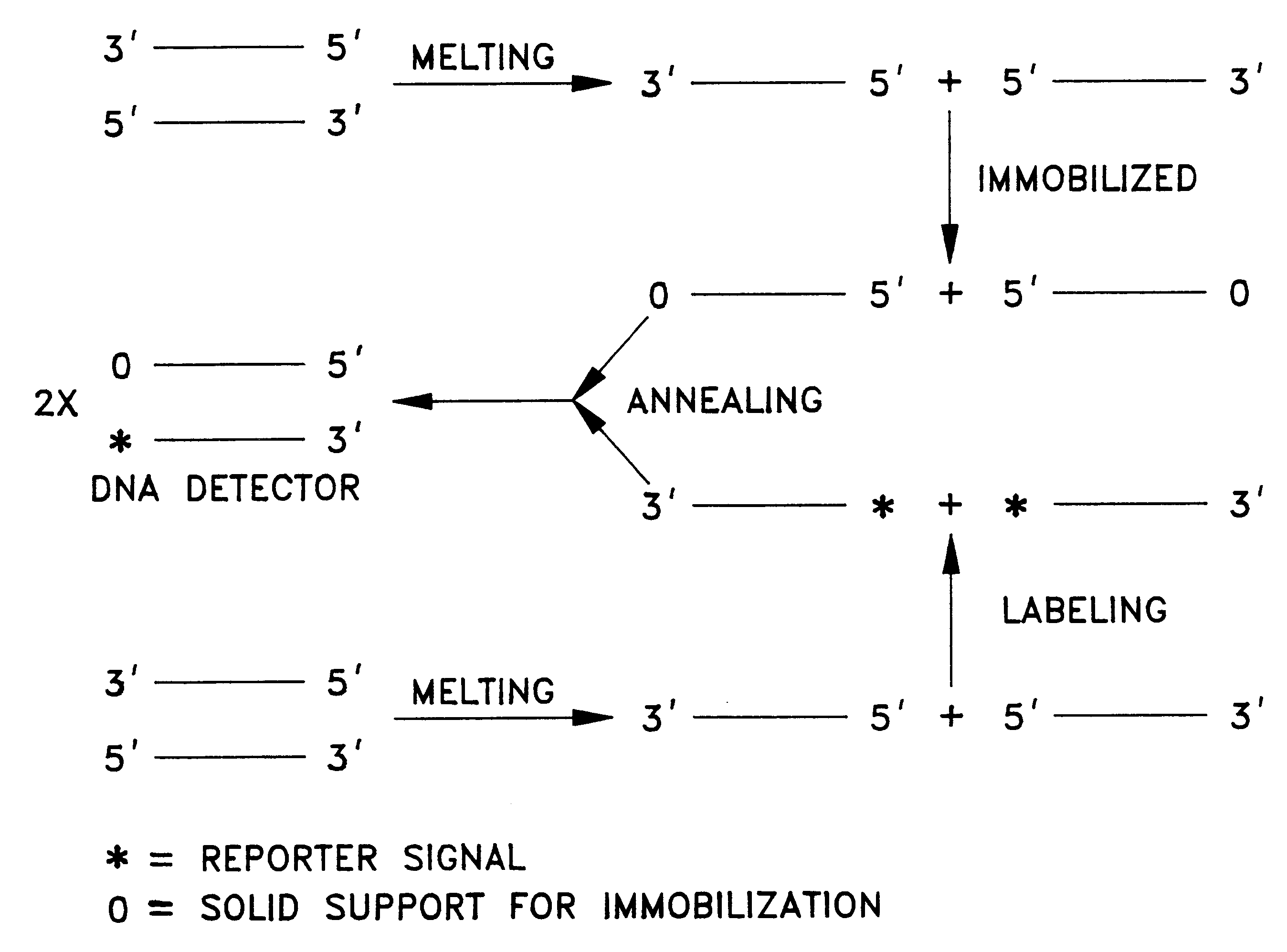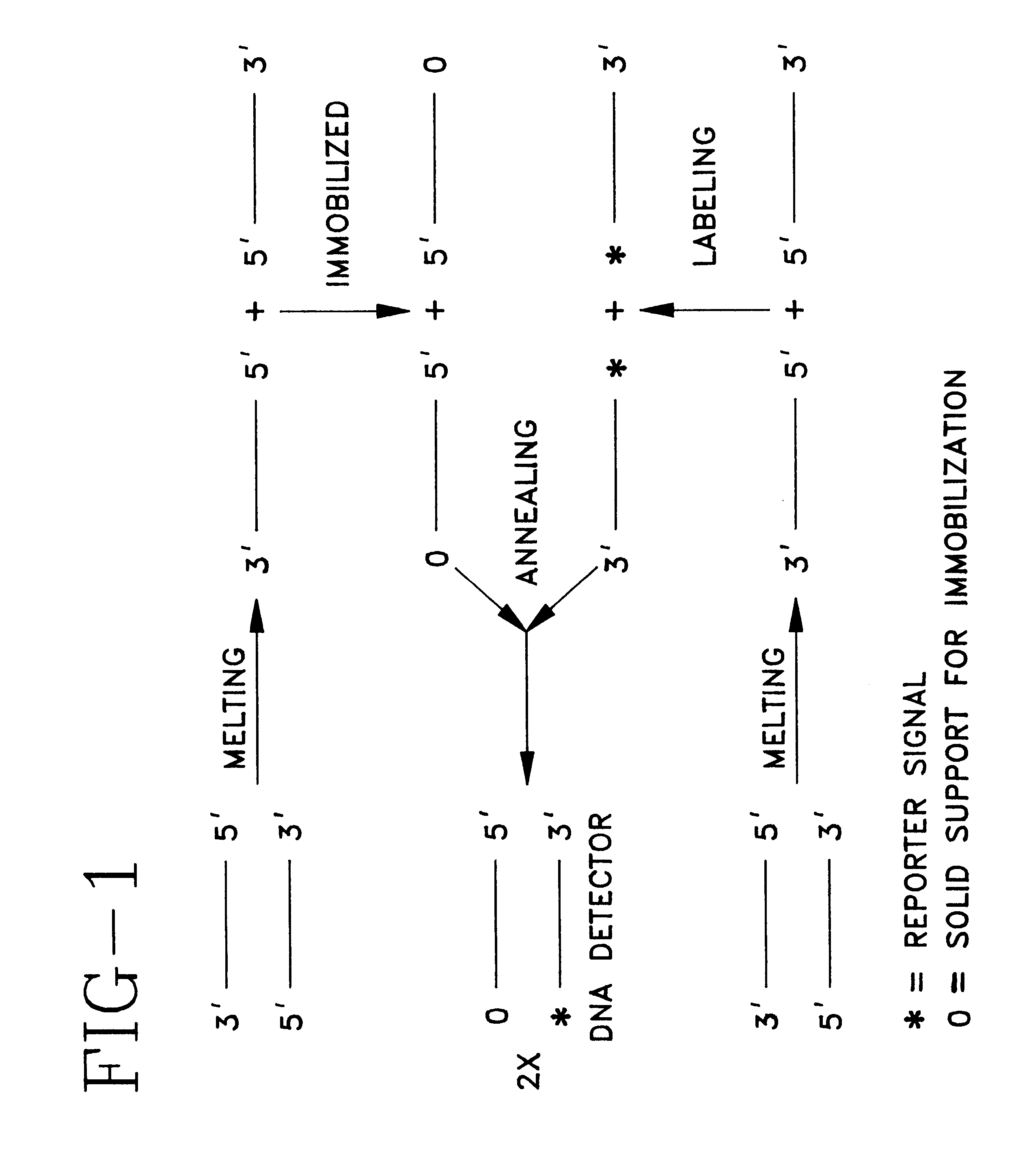Detector for nucleic acid typing and methods of using the same
a nucleic acid typing and nucleic acid technology, applied in the field of nucleic acid typing detectors, can solve the problems of dna fragment size-sharing principle accuracy, lack of information about species individualization, and inability to provide unique and unequivocal comparisons and identifications, etc., to achieve the effect of convenient design and construction
- Summary
- Abstract
- Description
- Claims
- Application Information
AI Technical Summary
Benefits of technology
Problems solved by technology
Method used
Image
Examples
example 1
Methods for the Preparation of DNA Detector Molecules
A. Construction of Immobilized Strands of the Detector Molecules
I. Preparation of VNTR Hybridization Probes
Oligonucleotides were synthesized on an automated Beckman Oligo 1000M DNA Synthesizer and all reagents were provided by the Beckman. The synthetic procedure as commenced in a column containing a porous silica gel solid support with an initial first nucleoside (CA, dC, dG, dT) attached thereto, by means of a phosphate backbone or a polylinker at the 3' end. Subsequent nucleosides were added one at a time consecutively to the 5' end of the growing oligonucleotide. The sequence addition of each of the nucleosides was controlled automatically through menu-driven software using a keypad and display screen, as described in the Beckman operation manual. A sequence having a length larger than 100 bases may optionally be prepared by linkage of fragments having less than 100 bp using DNA ligase or transferase or the like, while the fir...
example 2
Purification of DNA from Whole Blood of an Unnamed Individual
The isolation of a nucleic acid analyte from a human blood samples is exemplified as follows. In brief blood cells donated by an individual were lysed and the DNA fraction was collected, separated from RNA and proteins, and amplified by PCR. Further details are provided below.
1. Materials
Cell Lysis Solution was prepared with 0.2 M NaOH and 1 % SDS. Cell resuspension solution was prepared to contain 50 mM Tris-HCl, 10 mM EDTA, and 100 .mu.g / mi RNAase A. Column wash solution for Wizard plus minipreps system contains 190 mM potassium EDTA. Direct purification buffer includes, 50 mM KCl, 10 mM Tris-HCl, pH 8.8, 1.5 mM MgCl, 0.1% Triton X-100, guanidine-HCl, 7 M (100 ml) and guanidine-HCl 4.5 M / isopropanol, 40%. The neutralization solution contains 1.32 M potassium acetate. pH 4.8. TE buffer contained 10 mM Tris-HCl, pH 7.5 and I mM EDTA.
2. Methods of Sample Collection and Preparation
a. Whole blood was collect...
example 3
Hybridization of Genomic DNA with Probes in Solution
1. Reagents
Hybridization buffer for use with synthetic probes was freshly prepared from the following components:
3 ml 10% PVP (polyvinylpyrrolidone);
3 ml 10% BSA;
3 ml 10% Ficoll 400;
15 ml 20.times.SSC buffer stock; and
the above mixed with water to a final volume of 150 ml.
SSC Buffer 20 X:NaC1 was prepared from:
NaCI, 3 M
175.3 g Na-citrate-2.H20, 0.3 M, 88.2 g
The pH was adjusted to 7.0 with 1 M HCl
Water was then added to a final volume of I liter
2. Hybridization in Solution
In the presence of 500 .mu.l of hybridization buffer, 1-2 .mu.g of genomic DNA and 1-2 .mu.g of one of the probes set forth in Table 2, above. To this solution was added 50 .mu.l of 10 M NaOH. 300 .mu.l of 2 M Tris. pH 7.4, and 475 .mu.l of 1 M HCl (added dropwise, with swirling to provide gentle mixing). The mixtures were then incubated at 85.degree. C. overnight.
The next day, the mixture was cooled to room temperature and the genomic DNA-labeled DNA-probe complex...
PUM
| Property | Measurement | Unit |
|---|---|---|
| Mass | aaaaa | aaaaa |
| Mass | aaaaa | aaaaa |
| Mass | aaaaa | aaaaa |
Abstract
Description
Claims
Application Information
 Login to View More
Login to View More - R&D
- Intellectual Property
- Life Sciences
- Materials
- Tech Scout
- Unparalleled Data Quality
- Higher Quality Content
- 60% Fewer Hallucinations
Browse by: Latest US Patents, China's latest patents, Technical Efficacy Thesaurus, Application Domain, Technology Topic, Popular Technical Reports.
© 2025 PatSnap. All rights reserved.Legal|Privacy policy|Modern Slavery Act Transparency Statement|Sitemap|About US| Contact US: help@patsnap.com



